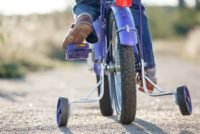Starting in the fall of 2015, all second graders in D.C. public schools were required to learn to ride in PE class.
 Before the start of the new school year in Washington, D.C., as families were buying supplies and teachers were drafting their lesson plans, Miriam Kenyon was spending her days in a warehouse in the city’s Northeast quadrant, surrounded by bikes.
Before the start of the new school year in Washington, D.C., as families were buying supplies and teachers were drafting their lesson plans, Miriam Kenyon was spending her days in a warehouse in the city’s Northeast quadrant, surrounded by bikes.
She and a group of volunteers were building them: Diamondback Vipers and Mini Vipers, 16- and 20-inch kids’ models. “They’re BMX bikes, so they’re really sturdy and they’re made for multiple uses,” explains Kenyon, the director of health and physical education at District of Columbia Public Schools (DCPS).
All the bikes in the warehouse—a huge fleet numbering 475—had to be ready by the time the first bell rang on August 24. Once assembled, they were divvied up and shipped to elementary schools for a novel educational experiment.
The goal: to teach every second grader in the city’s school system how to ride a bike.
“Every kid should know how to ride a bike,” Kenyon says. “It’s a great way not only to get to school, but to exercise, and to see your city. It promotes independence.”
Bike safety instruction is fairly common in schools around the United States. In D.C., the nonprofit Washington Area Bicyclist Association sends instructors into schools as part of the national Safe Routes to School program. The instructors teach safety basics and bring in bikes and helmets so the kids can practice their skills.
But that’s not the same thing as teaching kids how to ride, which typically doesn’t happen at school. Dan Hoagland, WABA’s education director, started noticing on his school visits that “large cohorts of students” in D.C. couldn’t ride at all. He talked about it with Kenyon. “In the back of my mind, as I ran these programs, I thought, ‘How do we figure out a way to more comprehensively approach bike education for kids?’”
Earlier this year, Kenyon discovered how: through a DCPS initiative called Cornerstones. New this fall, Cornerstones assigns common projects to students across the city—a core curriculum in miniature, basically. Officials hope it will improve academic rigor and narrow the achievement gap that separates affluent and poor, white and black students.
When Cornerstones was announced, Kenyon saw her opportunity and grabbed it. Bike-riding instruction could become a Cornerstone project in physical education. The District Department of Transportation agreed to fund the purchase of 475 bikes, and a universal bike-riding program—the first of its kind in a U.S. school district—was born.
Here’s how it works: The bikes will rotate around schools. The fleet is large enough for a quarter of the 79 elementary schools in DCPS to have 25 bikes at a time, so every child in a PE class should be able to get his or her own bike and helmet. (When there aren’t enough bikes to go around and the kids have to share, they don’t get as much hands-on time.)
The bikes will stay in the first set of schools—a cross section spread across the city—for several weeks. Then they’ll move to another set of schools, and so on, until the end of the school year, when every second grader in the city will have completed the program and, assuming all goes well, can pedal with confidence. Kenyon has ordered another 475 bikes with DCPS funding, so eventually, there will be enough to serve half of the schools in the fall, half in the spring.
The choice of second grade was deliberate. Kenyon realized it would be impossible for a PE teacher to get 20 or more non-riders proficient within weeks. So Kindergarten and Pre-K—years when many or most kids can’t ride—were out. But waiting too long would cause problems, too; older kids who don’t know how to ride can be embarrassed or scared of falling.
“We had to pick an age group where some kids know how to ride and some don’t,” Kenyon says, and second grade was the sweet spot. While the non-riders learn the essentials, experienced cyclists will be able to hone their skills on the obstacle course or complete a challenge like the how-slow-can-you-go “snail ride.”
“We had to pick an age group where some kids know how to ride and some don’t,” Kenyon says, and second grade was the sweet spot.
To celebrate the end of the course, each class will do a half-day group ride from the school to a local park and back. Kenyon has mapped a five-to-seven-mile route around every elementary school, with a shorter loop for fledgling riders. “We can take them to a safe place to bike, like Anacostia Park or Fort Dupont Park or Rock Creek Park. They can see beautiful areas of their city and enjoy them by riding.”
An avid cyclist herself, Kenyon grew up in a bike-loving family in D.C. When she was seven, she recalls, the family vacation was a ride to Harpers Ferry, West Virginia, some 60 miles away. But the goal of the new program isn’t to produce long-distance riders.
Urban biking has a well-documented equity problem. As Capital Bikeshare expands and D.C. adds more bike infrastructure, there’s a danger that low-income residents will be left out of the city’s two-wheeled renaissance. Universal bike education could prevent that.
The proverbial wisdom of “as easy as riding a bike” doesn’t always hold true in low-income neighborhoods. There are many reasons why a poor kid might not learn to ride: Buying a bike is out of reach for some families. Parents are understandably concerned about their kids’ safety on the street. The best and safest places to bike, the protected lanes and park trails, are more likely to be across town.
If every kid in D.C. learns to ride a bike, none of those barriers will disappear. But bike-riding kids have more freedom to explore their city, and that’s a small defense, at least, against worsening spatial segregation.
More young people of all backgrounds will be able—and motivated—to use resources that now skew to D.C.’s professional classes. And they will grow into bike-riding adults, who can enjoy recreational biking or commute by bike if they choose, and lobby for safe, pleasant places to bike wherever they live.
That’s great news for anyone who cares about their city being equitable. Bike advocates, who traditionally haven’t focused much on families and kids, grasp the importance of programs like Kenyon’s.
“We can’t survive if we’re only going after the white, bearded guys with bikes,” Hoagland admits. “If we want to create the next generation of advocates, we need to make sure they’re enjoying and excited about bicycling from as young an age as possible.”
Written by Amanda Kolson Hurley for the The Atlantic City Lab ~ September 1, 2015.
 FAIR USE NOTICE: This site contains copyrighted material the use of which has not always been specifically authorized by the copyright owner. We are making such material available in our efforts to advance understanding of environmental, political, human rights, economic, democracy, scientific, and social justice issues, etc. We believe this constitutes a ‘fair use’ of any such copyrighted material as provided for in section 107 of the US Copyright Law. In accordance with Title 17 U. S. C. Section 107, the material on this site is distributed without profit to those who have expressed a prior interest in receiving the included information for research and educational purposes. For more information go to: http://www.law.cornell.edu/uscode/17/107.shtml
FAIR USE NOTICE: This site contains copyrighted material the use of which has not always been specifically authorized by the copyright owner. We are making such material available in our efforts to advance understanding of environmental, political, human rights, economic, democracy, scientific, and social justice issues, etc. We believe this constitutes a ‘fair use’ of any such copyrighted material as provided for in section 107 of the US Copyright Law. In accordance with Title 17 U. S. C. Section 107, the material on this site is distributed without profit to those who have expressed a prior interest in receiving the included information for research and educational purposes. For more information go to: http://www.law.cornell.edu/uscode/17/107.shtml

The idea on the surface is a noble one, but… where have their parents been? I knew how to ride a bile long before ever attending school. Once again – the ‘system’ is relegated to raising the children – a task that they are ill equipped to do. ~ J.B.